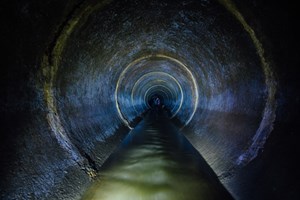Vermont’s wastewater infrastructure deemed “poor” by engineering group
(UI) — The Vermont section of the American Society of Civil Engineers (ASCE) released the 2023 Report Card for Vermont’s Infrastructure on Feb. 16, with nine categories of infrastructure receiving an overall grade of "C". Specifically, the state’s wastewater infrastructure received a grade of “D+”, with its drinking water receiving a “C” score and a “C-” for its stormwater infrastructure. According to the report, a C is considered “mediocre” while a D is “poor.”
The report card details opportunities to transform Vermont’s infrastructure with funding from the Bipartisan infrastructure Law (BIL) passed in November 2021. Already more than $800 million in projects funded by the BIL have been announced in Vermont. However, the report shows why more long-term funding is needed to maintain and improve the critical infrastructure systems people across Vermont depend on daily as the state moves towards ambitious environmental goals and confronts the effects of climate change on aging systems.
"As we know all too well here in Vermont, there has been endless discussion in Washington, for decades in fact, about the need to rebuild our nation’s crumbling infrastructure," said Vermont Senator Bernie Sanders. "Infrastructure is the backbone of our communities and our economy. Yet year after year, Washington has underinvested in our aging, essential structures. While Vermont is in better shape than many other states, we still have a long way to go. A ‘C’ grade is not good enough to me and it is not good enough for Vermont."
Drinking Water (C) and Wastewater (D+)
Public drinking water systems serve 59% of Vermont residents, while the rest are served by wells or other private water systems. More than 95% of water utilities in the state are in compliance with state and federal regulations. Vermont residents pay on average $46 a month for water, compared to the national average of $68.
However, those lower costs for customers mean many water systems make just enough money to cover operating expenses and have limited reserves for large projects. Vermont faces a 2024 deadline to come up with a lead service line replacement plan. Green Mountain State lawmakers say the state needs $374 million in water repairs and upgrades. The Bipartisan Infrastructure Law will provide Vermont with $355 million over five years to address water contamination and replace lead service pipes.
Wastewater received the lowest grade in the report card with a D+. Only half of Vermont’s population is served by public wastewater systems, while the rest depend on septic systems which can cause public health hazards and water pollution if they fail. In 2021, Vermont spent just $12 million on wastewater infrastructure, compared to $29 million in 2018. Many wastewater systems are more than 100 years old and need extensive repairs.
Solid waste systems in Vermont also face challenges moving forward. The average household generates just over 1,300 pounds of waste a year, much higher than the state’s goal of 1,000 pounds per year for 2024. The state is also short of goals when it comes to how much waste is diverted away from landfills or incinerators. As recycling increases and landfill use decreases, solid waste faces new funding challenges because fees are based on the amount of waste disposed.
The Report Card was created as a public service to citizens and policymakers to inform them of the infrastructure needs in their state. Civil engineers used their expertise and school report card-style letter grades to condense complicated data into an easy-to-understand analysis of Vermont’s infrastructure network. ASCE State and Regional Infrastructure Report Cards are modeled after the national Infrastructure Report Card, which gave America’s infrastructure an overall grade of ‘C-’ in 2021.
Related News
From Archive

- Glenfarne Alaska LNG targets late-2026 construction start for 807-mile pipeline project
- U.S. water reuse boom to fuel $47 billion in infrastructure spending through 2035
- $2.3 billion approved to construct 236-mile Texas-to-Gulf gas pipeline
- Major water pipe break in Puerto Rico hits over 165,000 customers
- Potomac River Tunnel project enters construction phase beneath Washington, D.C.
- Pennsylvania American Water launches interactive map to identify, replace lead water service lines
- Trump's tariffs drive $33 million cost increase for Cincinnati sewer project
- Utah city launches historic $70 million tunnel project using box jacking under active rail line
- Tulsa residents warned after sewer lines damaged by boring work
- Fatal trench collapse halts sewer construction in Massachusetts; two workers hospitalized




Comments